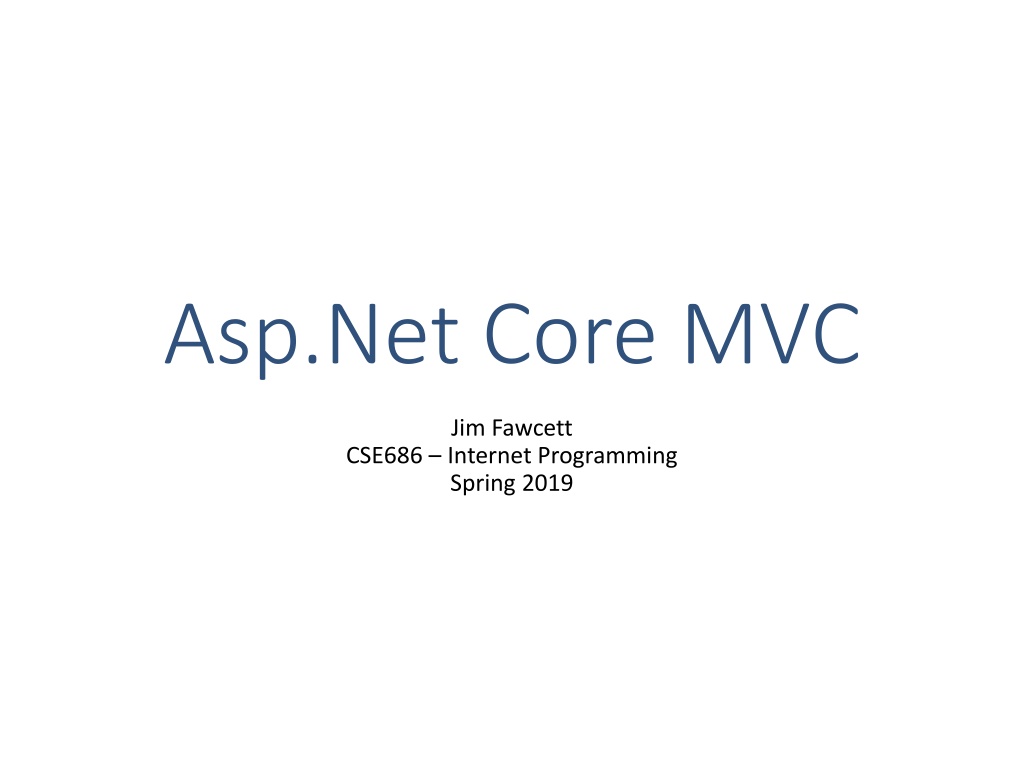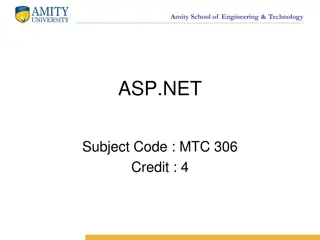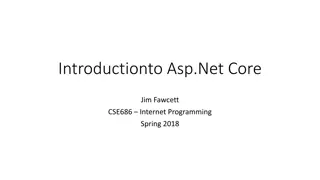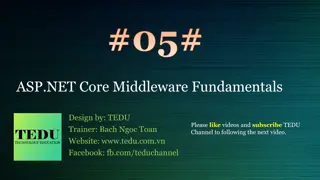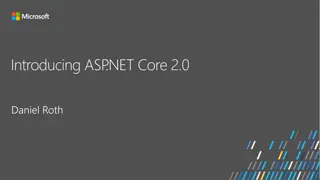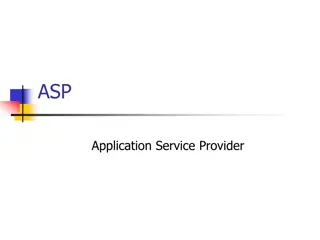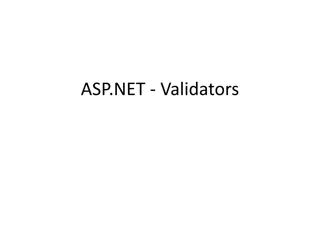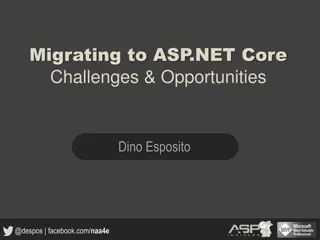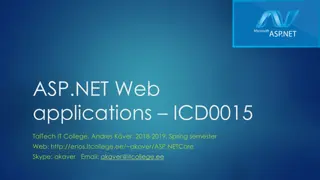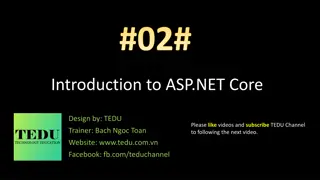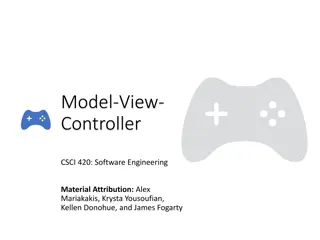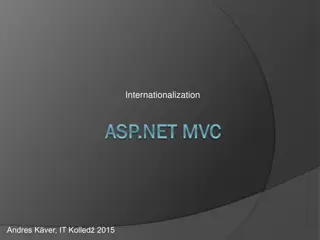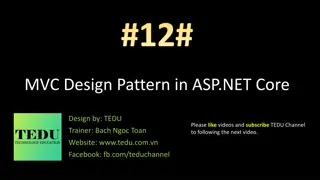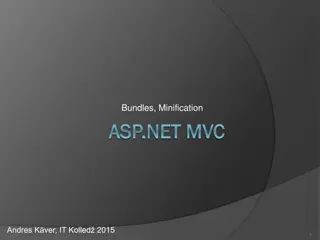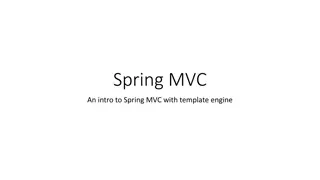Understanding Asp.Net Core MVC - Building Web Applications with Model-View-Controller Pattern
Asp.Net Core MVC is a framework for building web applications based on the Model-View-Controller pattern. The model manages application data and constraints, views present application state, and controllers handle requests and actions on the data model. Learn about the MVC structure, life cycle, models, views, and how to add a model in Asp.Net Core MVC.
Download Presentation

Please find below an Image/Link to download the presentation.
The content on the website is provided AS IS for your information and personal use only. It may not be sold, licensed, or shared on other websites without obtaining consent from the author. Download presentation by click this link. If you encounter any issues during the download, it is possible that the publisher has removed the file from their server.
E N D
Presentation Transcript
Asp.Net Core MVC Jim Fawcett CSE686 Internet Programming Spring 2019
What is Asp.Net Core MVC? Framework for building web applications Based on Model-View-Controller pattern Model manages the application data and enforces constraints on that model. Often accessed through persistent objects Views are mostly passive presentations of application state. Views generate requests sent to a controller based on client actions. Controllers translate requests into actions on the data model and generate subsequent views.
Mvc Structure Controllers Connect Views to Data Models Provide structured data, usually persisted to a db Accessed through C# class instances Views Combine markup and C# code to display and accept data.
MVC Life Cycle Clients request a named action on a specified controller, e.g.: http://localhost/aController/anAction The request is routed to aController s anAction method. That method decides how to handle the request, perhaps by accessing a model s state and returning some information in a view. User actions in the view, e.g., data entered, button presses, result in get (ActionLink) or post (Button) requests to a specific controller action. That process may repeat for many cycles.
What is a Model? A model is a file of C# code and often an associated data store, e.g., an SQL database or XML file. The file of C# code manages all access to the application s data through objects. Linq to SQL and Linq to XML can be used to create queries into these data stores This can be direct More often it is done through objects that wrap db tables or XML files and have one public property for each attribute column of the table.
Adding a Model Right-click on Model folder and select Add Class. Populate the model class with public properties that represent data to be managed. Usually the model is persisted to an XML file or SQL database using LINQ or the Entity Data Framework.
What is a View? Views are cshtml files with only HTML and inline C# code, e.g., <td>@crs.Number, @crs.Name Code is used just to support presentation and does no application processing. The HTML is augmented by HTML Helpers, provided by Asp.Net Core MVC that provide shortcuts for commonly used HTML constructs, e.g.: @Html.ActionLink( Edit , Edit , new { id = crs.Id }) Asp.Net MVC also provides tag helpers that translate into pure markup, e.g.: <input asp-for= Name />
Html Helpers ActionLink: links to an action method CheckBox DropDownList EditTextBox Hidden ListBox Password RadioButton TextArea TextBox
Adding a View Right-click on View folder select Add View and configure view from the resulting dialog. It s easy to generate tables and lists that can be edited and posted back to the controller to effect changes to its model. The HTML helpers on the previous page make building a view a fairly simple process. The wizard for Strongly Typed views does most of the work in rendering model details.
What is a Controller? A controller is a C# class that derives from the class Controller. A controller defines some category of processing for the application. Its methods define the processing details. Routing to a controller is defined in Startup.Configure method.
Data Binding If a controller method takes a model class as a parameter, then the MVC infrastructure will instantiate an instance and pass to the controller method when requested via a url. On postback, if View parameters have the same names as model names, then the MVC infrastructure uses reflection to bind current view values to the model.
MvcSkeleton with CRUD Controller Action methods
Action returns ActionResult ActionResult: base class ContentResult: user defined object to Response EmptyResult: Nothing to Response FileResult: Send binary file to Response RedirectResult: redirect to url RedirectToRouteResult: redirect using routes JasonResult: send json to Response JavaScriptResult: send Javascript to Response ViewResult: Render a view
Adding a Controller Right-click on the Controller folder and select Add Controller. Populate controller with methods whose names will become views and that take model parameters to supply views with data and react on postback to data changes made in view.
Web Application Development Create a new Asp.Net Core MVC project Delete any part of that you don t need Add a controller for each category of processing in your application: A category is usually a few pages and db tables that focus on some particular application area Add methods to each controller for each request you wish to handle. Add views as needed for each controller action Add Model classes to support the application area: Each model class has public properties that are synchronized with data in the model db or XML file.
An Opinion This Asp.Net Core MVC structure is very flexible: You can have as many application categories as you need, simply by adding controllers. The controllers keep the application well organized. You can have as many views as you need. The navigation is simple and provided mostly by the MVC infrastructure, e.g., routing. You can have as many models as you need. Just add classes and use Linq to access the data.
Things you may use LINQ Language integrated query Linq to XML and Linq to SQL are commonly used by models to provide data needed by a controller for one of its views.
